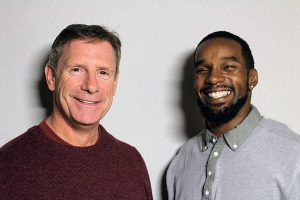Today, we begin our annual four-part pro-life series: The first three presentations will be on euthanasia, the last on abortion. Last year’s topic of in-vitro fertilization began with mercy, so today, let’s also begin with mercy. Some of us know people who have chosen euthanasia; they’ve chosen to end their lives for various reasons, and, in Canada, may have sought the help of physicians in doing so. Perhaps some of us have thought about what we’ll do when we’re older, dying, or in great pain.
In 2005, Kevin Berthia and Officer Kevin Briggs met at the Golden Gate Bridge in San Francisco. Berthia was there to jump: Always struggling with severe depression, he now had a baby who had been born premature, along with a $200,000 medical bill that he couldn’t afford. Officer Briggs was called in and spoke to Berthia for an hour and a half, as he was leaning over the ledge, and persuaded him not to jump.
Berthia is now a father of three and a suicide prevention advocate. Let’s try to understand what he was going through and empathize with his pain. And let’s ask three questions: Is it good that these men work in suicide prevention? Would it be equally good if they worked in suicide assistance? Did Officer Briggs do something right or something wrong by stopping Berthia’s suicide? (Stephanie Gray, On Assisted Suicide, 20-21).
One other story. Two people worked at Walmart, one of whom was at the end of her life because of spinal cancer and experiencing excruciating pain. She filled out paperwork for assisted suicide and, when she asked her co-worker to witness it, the friend gently said, “I can’t do that.” Sitting next to her, she asked, “What are you most afraid of?” “The pain!” So the friend asked if they could consult palliative care to see what options were available to control the pain, and also promised to visit. In the end, the woman changed her mind. Most of the pain, not all, was controlled so there was still some suffering, but, the woman also admitted there were moments of joy. She passed away within a week because of the cancer (70).
The truth we see revealed in the First Reading and Gospel is that, whenever we encounter holiness, there is a corresponding mission. Both texts have the same three-part structure: 1) An encounter with holiness: Isaiah is in the Temple, has a vision of the Lord sitting on a throne as well as of angels; and there is an earthquake and smoke—all signs in the Old Testament of God’s revealing Himself; in the Gospel, Jesus tells Peter to let down the nets for a catch, but he objects that they did that all night and caught nothing; when he does, however, the group brings in so many fish that the nets are close to breaking and they’re about to sink—the point is that this catch is basically impossible.
2) A reaction of unworthiness: Isaiah says, “Woe is me! I am lost, for I am a man of unclean lips” (Is 6:5); Peter says, “Go away from me, Lord, for I am a sinful man!” (Lk 5:8).
3) Receiving a mission: The Lord says, “Whom shall I send, and who will go for us?” and Isaiah responds, “Here I am; send me” (6:8-9); Jesus says, “Do not be afraid; from now on you will be catching people” (5:10).
Likewise, whenever we encounter another human person, we’re meeting someone made in the image and likeness of Jesus, and so must treat that person with reverence; there is something sacred in every person, starting with their life, which is given by God. This is the first of three reasons why euthanasia is wrong: It goes against the natural intuition for life. (We’ll cover the other two in the following weeks.) For example, during COVID, what did everyone fear? Death. What was the world’s response? Preserve life. Or, if we run into a friend who tells us that their first child or grandchild is born—our reaction? ‘Congratulations!’ Later, that same person tells us that they have cancer—our reaction? Sadness. There was a program on Animal Planet TV called I Shouldn’t Be Alive, documenting real-life stories of people trapped in avalanches, canyons, etc., and the taglines for the show are, ‘Never give up!’ ‘There is strength within us all… The will to survive.’ This shows that the overriding desire of the human person is to seek life against all odds. Finally, the Harvard T.H. Chan School of Public Health reported that nine out of ten people “who attempt suicide and survive will not go on to die by suicide at a later date… This shows that a desire to die is not permanent” (76).
So, when people sign up for assisted suicide, it’s not because they want to die. It’s for another reason: They feel useless; they’re lonely; they’re in pain. I sometimes joke with people: You know how some people want to euthanize themselves during a boring homily, because they want to end the suffering? What happens is that, when the homily is over, they don’t want to die anymore. So, euthanasia is also wrong because it doesn’t solve the underlying problem.
Once, a nurse saw on a patient’s chart that she had inquired about euthanasia. Because the nurse was pro-life, she decided to spend more time with that woman than others. And, instead of talking about euthanasia, she got to know the woman and her background, and talked about what they shared in common. A few weeks later, on the chart, the woman was no longer investigating euthanasia (109).
This is a beautiful example of the truth we see in the Readings: When we encounter the sacredness of people, we’re called to love and serve them!
Here is a famous and sad story:
Now, because people are sacred, does that mean we should prolong life at all costs? No. This is a common misunderstanding. Catholic moral teaching doesn’t say we have to use every medical means to keep a person alive. It just says that we have to use what is defined as Ordinary Care, that is, “the basic care to preserve the life of the person” (e.g., food, hydration, cleaning, pain medication). Ordinary care is morally obligatory.
I strongly encourage everyone, if we have a real case question regarding someone we love and their end-of-life care, please go to this website, the National Catholic Bioethics Centre, because they take both phone calls and emails.
Finding answers is one of the most loving things we can do. Other simple actions include: holding someone’s hand while listening to beautiful music; reading to them; playing board games; transcribing their life lessons; acting as their interpreter if blinking is their only way of communication; wiping food off someone’s face; hugging them (Gray, 61). One social worker visits people suffering from dementia, finds out what they liked to listen to when they were younger, and creates an individualized playlist for them, because they come alive when listening to music they recognize. At the end of Mass, we’re having someone from Birthright speak to us, and I’d really encourage everyone to donate and even volunteer.
Also, as we’ve done now for the past four years, in three weeks, we’ll show graphic photos and videos of what abortion does, so that we know the truth.
And, on these dates, we’re going to do our annual 40 Days for Life prayer witness. Next week, Liera will have cards for us, so we can start signing up. Thank you!
Euthanasia is wrong because it goes against the natural intuition for life. We can understand why people sometimes may want to die. But they’re still sacred, and so, our mission is not to cause their death, but to alleviate their suffering and love them.


